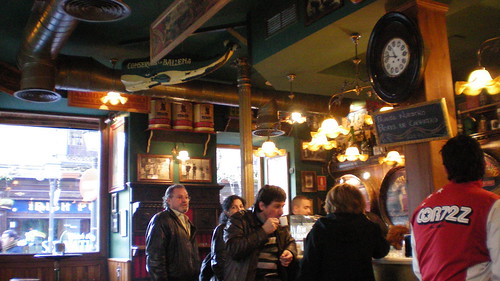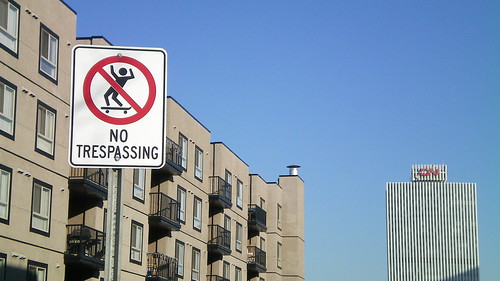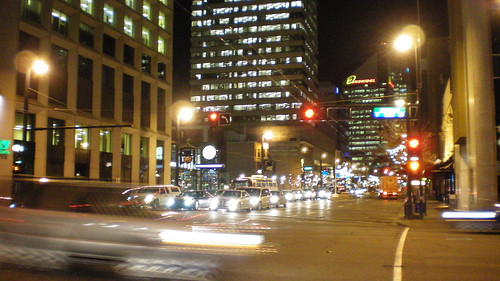Place, Space and City

Artigo publicado na revista Liminalities, “Making Sense of the City: Place, Space, and Rhetoric in Portland’s Pioneer Courthouse Square”, de Erin Daiana McClellan, retoma as discussões sobre lugar, espaço e significado do uso das cidades que tenho feito aqui no Carnet.
Alguns trechos interessantes para a nossa discussão sobre lugar e locative media:
“Each city is often connected to a central public square in discussions of the city’s
health, culture, and demographics. And each public square often (re)presents itself to the world in terms of the city within which it resides. The public square, in this case, plays a pivotal role in determining how people make sense of the written, oral, and performative texts that are consumed within and about it. Such sense-making processes include individual and collective interpretations of public squares, which take into account two different types of understanding: spatial (grounded in concepts of space) and platial (grounded in concepts of place). Both spatial and platial approaches to understanding always require each other in some degree but continually appear as privileged or disadvantaged in particular sense-making processes of how some aspect of public life is meaningful. In other words, place functions in an inherently dialectical tension with space; both are used in sense-making processes, articulated in discourses, and performed in meaningful ways. Understanding a city’s public space requires both understanding how that space is made sense of in terms of particular places, and how a particular place provides definitional parameters for making sense of more abstract public discursive space. A central public square is one way that this abstract-tangible, space-place relationship can be seen to appear in the ways its users articulate and perform its meaning.

(…) For instance, a person without a home may make sense of a public square as a place to sit without getting hassled, while a tourist visiting the same square may make sense of it as an historical landmark. This tension does not preclude collective negotiation to reconcile different sense-making processes or even coexisting contradictory meanings, but it does require recognizing the multiplicity of possibilities, including verbal, Portland’s Pioneer Courthouse Square …
(…) Recent theoretical distinctions have been made between place and space in rhetorical studies, most often in an attempt to discuss public memory in relation to museums, monuments and other public commemorative structures, and landscapes. But other disciplines have produced scholarship also attempting to differentiate the terms conceptually before practically concerning themselves with the effects. For instance, Philip Sheldrake argues that the difference between place and space exists in the (lack of) concreteness of each term. Place, in this distinction, is a concrete and tangible entity and space is abstract and intangible. Space generally refers to abstract and intangible evocations of discourse, as a host to discourse about place, or as an overarching contextual backdrop in which discourse occurs. Place, on the other hand, is generally discussed as a physical or tangible entity in which social, political, and cultural discourses are understood, a limited or bounded area in which rhetoric emerges in and about, or as an approachable or exclusionary tool for making sense of a larger discourse in specific ways. Particular contexts require particular rhetorical strategies to be effective.

(…) Sometimes scholars have chosen to privilege space over place in their discussions of rhetorical ‘effect.’ For example, Benjamin Barber downplays place in terms of its relationship to democracy (and/or capitalism): ‘The communities that communitarians yearn for are not likely to flourish between the crowded freeways and the denuded public squares of an overweening commercial civilization, where corporate developers claim they have won another victory for democracy every time they build a new mall.’ Barber presents squares as connected places and very different than the destination for lively discussion of ‘public good’ that occurred in the Agora or polis of antiquity. The ‘public good’ in Barber’s discussion is determined not by all interested parties’ involvement in open debate, but by the most powerful voices that are able to effect the creation of policy. Instead of a collectively experienced and negotiated understanding, place for Barber is the effect of a larger system gone awry. The consequence of adopting this meaning, Barber claims, is a hyper-focus on the particular with little thought to how the particular affects the general. Without understanding that the larger community within which a public square resides may not need another commercial venue but instead an open and accessible forum within which to participate is a consequence of privileging one conception of place in a sense-making process about the square as meaningful.

(…) While Barber privileges space over place, others employ the idea of place over
space in their explanations of the public sphere. For instance, Sennett emphasizes place as the location where ideas take action. He grounds his concept of theatrum mundi, or the ability to hold codified beliefs that allow us to understand drama in the theater as apart from and simultaneously reflective of everyday social interaction, in the connection between performance of meaning and a larger sense of belonging. Place and space are coordinated in this manner but remain consequential in the way they are understood, employed, and interpreted in any given situation. For Sennett, the place where people gather signifies both the opportunities and constraints people understand to be a part of their sense-making processes of place. In this view, we can only perform what we understand to be possible ‘in the world.’ (…) Although the latter is engaged in specific discursive spaces with others, Sennett sees the physical places where these beliefs are enacted to be the more valuable in helping to understand how our cities are meaningful.
Rather than hypothesizing about abstract spaces that host ever-changing and competing discourses, Sennett points out that all experiences and social connections are all grounded in particular places. Similarly, all discursive spaces are bound by opportunities and constraints connected to the situations and places within which they occur. These practical reflections, however, often raise even more questions of possibility: If we are only able to create meaning based on our experiences grounded ‘in the world,’ then are we fated to live within the realm of current possibility forever? Can we ever move beyond the tangible constraints within which we understand the world to be meaningful? Or can we eventually imagine a world void of such tangible constraints that allow us to entertain possibilities of meaning not accessible in our current experience ‘in the world’?
(…) Edward Casey distinguishes between place and space by tracing the concepts back to their Greek roots. Place is associated with topoi, meaning the commonly negotiated and understood categories (commonplaces) that help us to make sense of our world in particular, tangible, and contestable ways; space is associated with chôra, referring to the “room” within which bodies move and is understood to shape those bodies’ opportunities in abstract, hypothetical, and intangible ways.
(…) First, place precedes rhetoric as a performance in itself. It provides material context for rhetoric, and in this way, can be understood to construct meaning and inform sense-making processes for individuals and collectives alike in particular and tangible terms and enactments. Second, space encompasses place and rhetoric in a way that allows for both to be imagined and negotiated in meaningful ways. Different people imagine (and practice) sense-making about a public square that reflects and engages larger understandings of opportunity and constraint presented in and about the city within which it lies. (…)”
